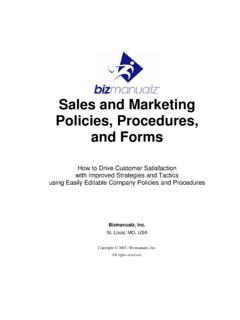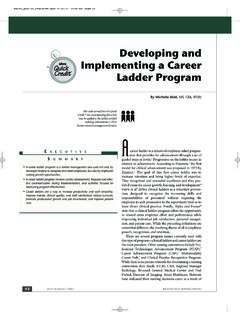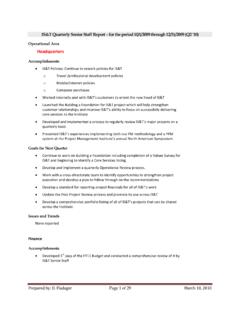Transcription of AWS Well-Architected Framework
1 ArchivedOperational Excellence Pillar AWS Well-Architected Framework July 2020 This paper has been latest version is now available at: Customers are responsible for making their own independent assessment of the information in this document. This document: (a) is for informational purposes only, (b) represents current AWS product offerings and practices, which are subject to change without notice, and (c) does not create any commitments or assurances from AWS and its affiliates, suppliers or licensors. AWS products or services are provided as is without warranties, representations, or conditions of any kind, whether express or implied.
2 The responsibilities and liabilities of AWS to its customers are controlled by AWS agreements, and this document is not part of, nor does it modify, any agreement between AWS and its customers. 2020 Amazon Web Services, Inc. or its affiliates. All rights reserved. ArchivedContents Introduction .. 1 Operational Excellence .. 1 Design 1 Definition .. 2 Organization .. 2 Organization Priorities .. 3 Operating Model .. 6 Organizational Culture .. 14 Prepare .. 18 Design Telemetry .. 18 Improve Flow .. 21 Mitigate Deployment Risks .. 24 Operational 26 Operate .. 30 Understanding Workload Health .. 30 Understanding Operational Health.
3 33 Responding to Events .. 35 Evolve .. 39 Learn, Share, and Improve .. 39 Conclusion .. 42 Contributors .. 42 Further Reading .. 42 Document 43 ArchivedAbstract The focus of this paper is the operational excellence pillar of the AWS Well-Architected Framework . It provides guidance to help you apply best practices in the design, delivery, and maintenance of AWS workloads. ArchivedAmazon Web Services Operational Excellence AWS Well-Architected Framework Page 1 Introduction The AWS Well-Architected Framework helps you understand the benefits and risks of decisions you make while building workloads on AWS. By using the Framework you will learn operational and architectural best practices for designing and operating reliable, secure, efficient, and cost-effective workloads in the cloud.
4 It provides a way to consistently measure your operations and architectures against best practices and identify areas for improvement. We believe that having Well-Architected workloads that are designed with operations in mind greatly increases the likelihood of business success. The Framework is based on five pillars: Operational Excellence Security Reliability Performance Efficiency Cost Optimization This paper focuses on the operational excellence pillar and how to apply it as the foundation of your Well-Architected solutions. Operational excellence is challenging to achieve in environments where operations is perceived as a function isolated and distinct from the lines of business and development teams that it supports.
5 By adopting the practices in this paper you can build architectures that provide insight to their status, are enabled for effective and efficient operation and event response, and can continue to improve and support your business goals. This paper is intended for those in technology roles, such as chief technology officers (CTOs), architects, developers, and operations team members. After reading this paper, you will understand AWS best practices and the strategies to use when designing cloud architectures for operational excellence. This paper does not provide implementation details or architectural patterns. However, it does include references to appropriate resources for this information.
6 ArchivedAmazon Web Services Operational Excellence Pillar 1 Operational Excellence The operational excellence pillar includes how your organization supports your business objectives, your ability to run workloads effectively, gain insight into their operations, and to continuously improve supporting processes and procedures to deliver business value. Design Principles There are five design principles for operational excellence in the cloud: Perform operations as code: In the cloud, you can apply the same engineering discipline that you use for application code to your entire environment. You can define your entire workload (applications, infrastructure, etc.)
7 As code and update it with code. You can script your operations procedures and automate their execution by triggering them in response to events. By performing operations as code, you limit human error and enable consistent responses to events. Make frequent, small, reversible changes: Design workloads to allow components to be updated regularly to increase the flow of beneficial changes into your workload. Make changes in small increments that can be reversed if they fail to aid in the identification and resolution of issues introduced to your environment (without affecting customers when possible). Refine operations procedures frequently: As you use operations procedures, look for opportunities to improve them.
8 As you evolve your workload, evolve your procedures appropriately. Set up regular game days to review and validate that all procedures are effective and that teams are familiar with them. Anticipate failure: Perform pre-mortem exercises to identify potential sources of failure so that they can be removed or mitigated. Test your failure scenarios and validate your understanding of their impact. Test your response procedures to ensure they are effective and that teams are familiar with their execution. Set up regular game days to test workload and team responses to simulated events. Learn from all operational failures: Drive improvement through lessons learned from all operational events and failures.
9 Share what is learned across teams and through the entire organization. ArchivedAmazon Web Services Operational Excellence Pillar 2 Definition Operational excellence in the cloud is composed of four areas: Organization Prepare Operate Evolve Your organization s leadership defines business objectives. Your organization must understand requirements and priorities and use these to organize and conduct work to support the achievement of business outcomes. Your workload must emit the information necessary to support it. implementing services to enable integration, deployment, and delivery of your workload will enable an increased flow of beneficial changes into production by automating repetitive processes.
10 There may be risks inherent in the operation of your workload. You must understand those risks and make an informed decision to enter production. Your teams must be able to support your workload. Business and operational metrics derived from desired business outcomes will enable you to understand the health of your workload, your operations activities, and respond to incidents. Your priorities will change as your business needs and business environment changes. Use these as a feedback loop to continually drive improvement for your organization and the operation of your workload. Organization You need to understand your organization s priorities, your organizational structure, and how your organization supports your team members, so that they can support your business outcomes.














